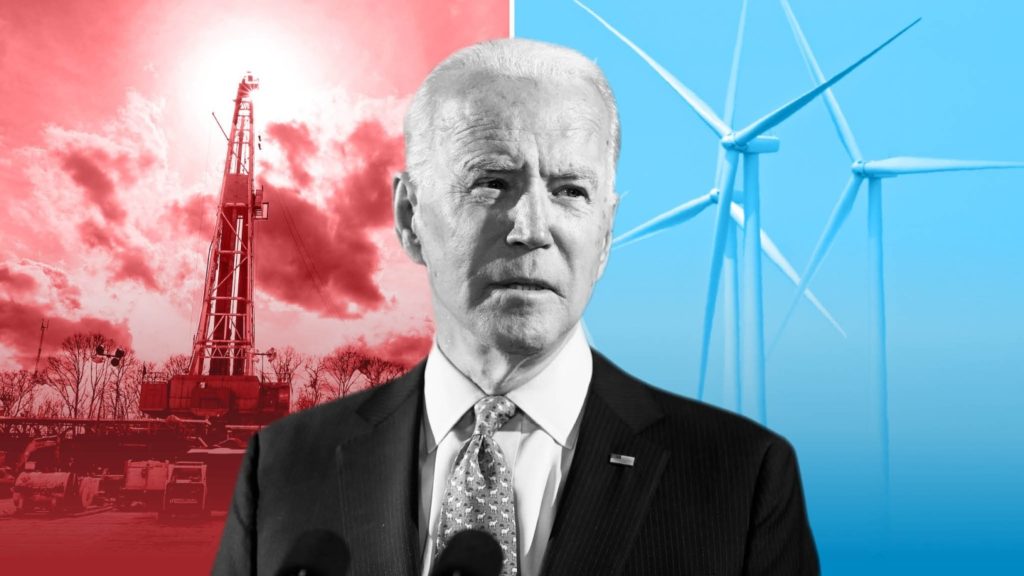The liberal consensus says Biden will offer a reprieve from the dark years of Trump and usher in a new era of climate-first policy. The journal Nature called Biden’s climate plan “revolutionary.” The Nation said “Biden’s climate plan is the strongest of any presidential nominee in history.” According to Mother Jones, Biden has the “most ambitious plans of any incoming president” when it comes to taking on global warming.
Upon closer inspection, however, what we see are more of the same climate proposals of the past: tax credits for businesses that upgrade to green technologies; the promotion of biofuels as an alternative to fossil fuels; the promise to take on the “real polluters,” like China. Biden does put forward some diluted Green New Deal proposals, but these aren’t likely to go far in a gridlocked Senate. The most likely scenario, however, is a return to the Obama climate agenda. The planet simply cannot afford middling solutions.
Trump’s Environmental Legacy
There is no question that the Trump presidency was a major blow to nature and, particularly, any global progress toward halting climate change. Trump withdrew in typical swaggering fashion from the already insufficient and unenforceable Paris climate agreement. Beyond that symbolic action, though, he succeeded in eroding many meagre existing climate and environmental protections on the books. It is particularly noteworthy that oil and natural gas production rose each year since he took office, though we may see a dip in 2020 as a result of the global coronavirus pandemic.
From the beginning, the Trump administration was filled with fossil fuel executives and lobbyists. Scott Pruitt, who has taken hundreds of thousands in campaign donations from the fossil fuel industry and who in the past sued the EPA on behalf of the utility companies, became head of the very same agency. Rex Tillerson, who was once chairman and CEO of ExxonMobile, served as Trump’s first Secretary of Energy. Ryan Zinke, a former congressman with a long history of support for the oil and gas sector, was placed as head of the Department of the Interior and dutifully served the fossil fuel industry by allowing for greater extraction by private corporations on federal lands.
The New York Times reports that Trump rolled back or loosened nearly 100 environmental regulations during his four years in office. The devastating actions by the administration included relaxing emissions restrictions on auto makers, easing measures aimed at curbing mercury pollution from oil and coal-fired power plants, removing protections on state land — most famously Bears Ears — and opening them up to future exploitation from the oil, gas and mining companies.
It is no wonder then that there was no progress in the past four years in reducing emissions at the rate needed to avoid 1.5 degree warming, the threshold beyond which “impacts may be long-lasting or irreversible” according to the IPCC. This year’s recession-driven dip is temporary. Once the global economy returns to previous levels of growth, we can expect emissions to return to, or even surpass, previous annual levels.
Will Biden Offer Any Answer?
Biden, in contrast, attempted to play both sides on the campaign trail, with language appealing to the big polluters and those voters rightly concerned with the climate emergency. The climate plan he outlined on his website states that he will use “the framework” of the Green New Deal, a plan backed by Sanders, AOC, and others in the party’s progressive wing. By doing so, Biden was able to attract many progressive voters that backed Sanders or Warren in the primaries. Some progressives, like Noam Chomsky, claim that the former vice president is putting forward a climate plan “farther to the left than any Democratic candidate in memory.”
At the same time, however, both he and Harris insisted they would not ban fracking and distanced themselves in their public statements from the Green New Deal. While stating that a transition away from oil and gas was necessary, Biden made clear “we’re not getting rid of fossil fuels for a long time.” This middle-of-the-road plan can only mean catastrophe. The notoriously conservative IPCC says we have 10 years to nearly halve global carbon dioxide emissions or else risk “irreversible loss of the most fragile ecosystems, and crisis after crisis for the most vulnerable people and societies.” Beyond his unwillingness to challenge the oil and gas companies, a Biden presidency poses a number of other major environmental threats. This includes his enthusiastic support for nuclear energy, a highly dangerous and costly energy solution.
The 2020 elections presented a clear example of how the lesser evil logic is so dangerous. Democrats knew they could get away with doing virtually nothing to challenge the fossil fuel companies as long as they remained slightly less reprehensible than the Republicans on the climate issue. Figures like Biden or Nancy Pelosi can support the Trump-backed USMCA — an enormous gift to the fossil fuel industry and a huge blow to workers — and continue to get elected with the support of progressives.
Obama’s Dubious Climate Legacy
We can also look at the legacy of the Obama administration for indicators of what is to come in the next four years. After all, Biden has already signalled that he will fill his cabinet with former Obama-era officials. This includes the expected nomination of Ernest Moniz as Energy Secretary. Moniz, who held the same post under Obama for four years, has been a former advisor to British Petroleum, one of the biggest polluters on the planet. We know these figures will put forward a strategy very similar to what they offered under Obama.
Obama was far from the climate champion he is often painted as. Obama himself boasted about building enough new oil and gas pipelines to “encircle the Earth and then some.” The former president earned high marks from institutional environmental groups, but he took extremely dangerous actions with respect to climate and the environment. It was not the Republicans, but Obama who granted ConocoPhillips the right to drill on previously protected land in Alaska, over strong opposition from Native communities and grassroots environmental activists. Greenpeace notes that the Bureau of Land Management leased land representing more than 2.2 billion tons of coal to private coal companies during Obama’s two terms in office. A significant amount of that coal was destined for export. So, while Obama was able to claim reductions in domestic emissions from coal, the United States was exporting these coal-driven CO2 emissions abroad. A record amount of coal was sent overseas in 2012.
The most important actions taken on climate issues during the Obama years were the suspensions of the Dakota Access and Keystone XL pipelines. But these actions were not at all a result of any independent initiative on Obama’s part. In fact, it was Obama himself who pushed them forward. The defeat of these projects was achieved through popular struggle: the fierce fight carried out by the Dakota Sioux people of Standing Rock and their supporters, who fought back against the pipelines and heavy police repression. It was these courageous activists, led by Native people, who fought back against the plans of Obama.The Prospect of a Green New Deal
Biden’s claim that he will use the framework of the Green New Deal for his own climate plan has generated a lot of enthusiasm among progressives. But would Biden’s GND-lite be sufficient to stave off a climate catastrophe? And what chance does it have of becoming a reality? Let’s begin by examining the original GND proposal.
The Green New Deal was an initiative put forward by environmental groups like Sunrise Movement and members of the Democratic Party’s progressive wing, like Bernie Sanders, Alexandria Ocasio Cortez, and the rest of the Squad. Its stated aim was to achieve 100% renewably sourced energy in the United States by 2030, overhaul the transportation system, upgrade energy grids, and make public investments in renewable energy, all while guaranteeing jobs at family-sustaining wages and universal healthcare.
As we’ve already noted elsewhere, the GND resolution has progressive demands but already contains many deficiencies. For example, it calls for public investment in private industry, meaning taxpayers will fund the plan while “green” corporations reap the profits. There is only vague language to assure us that the public will receive “appropriate ownership stakes and returns on investment.” The GND presents no challenge to the power of the world’s largest polluters. That is to say, the fossil fuel giants, the electrical utilities, the auto companies, and the airlines would all continue to rake in billions for their executives and shareholders so long as they adopt new emissions regulations. None would be held responsible in any meaningful way for the serious damage they’ve already inflicted on the planet.
Biden’s GND-lite
The Biden plan takes the GND and waters it down substantially. Whereas AOC estimated the GND to cost around $10 trillion over 10 years, Biden puts his plan’s cost at just $2 trillion over four years, signifying a 50% scaledown. Biden’s plan has neither a jobs nor a healthcare guarantee. Instead of upgrading and weatherizing all existing buildings as the GND calls for, Biden sets a “target” of 50% of upgrading buildings by 2035. He plans to weatherize 2 million homes across the U.S., when at least an order of magnitude larger than that is needed.
Beyond the differences in plans, we can expect very few of Biden’s climate proposals to become a reality — barring a major increase in struggle, of course. Even in the unlikely event that Democrats win both seats in the upcoming Georgia runoff and gain control of the Senate, there are still major obstacles to passing any climate measures. As we saw during Obama’s first term, Democratic control of the White House, Senate, and House was not enough to pass even modest measures like a public health insurance option. Joe Manchin of West Virginia, a conservative Democrat and friend of the coal industry, has already signalled he won’t be voting for a GND. We can reasonably assume that the most progressive measures of any Democratic climate plan, like a public works program financed by taxes on the rich, won’t be passing the Senate.
Biden’s defenders will content themselves with a series of executive orders more or less restoring the Obama-era status quo. Some action is better than none, they will tell us. Unfortunately for the more than one billion people directly threatened by a rapidly warming planet — not to mention a good deal of the existing biosphere — minimal action won’t prevent a catastrophe.
What Alternative Do We Have to the Biden Agenda?
What’s clear is that the answer to our climate emergency will not come from Democratic politicians, especially not those with long histories of anti-climate policies and actions. We must build on the powerful examples of the movements against the Dakota Access and Keystone XL pipelines to create a major climate movement that will take on the fossil fuel monopolies and the world’s largest polluters. To win any meaningful gains, it must link up with the labor movement’s most advanced sectors — workers like those at the GM plant, who during the early days of the outbreak, demanded production at their plant shift to the manufacture of life-saving medical equipment. Similarly powerful solidarity actions from workers in the fossil fuel, auto, and airline industries will be needed to confront the deepening climate crisis.
While the United States, Brazil, and other countries that have applied the neoliberal model have failed completely to contain the coronavirus pandemic, the more farsighted capitalist countries have already shown what planning can accomplish in the area of public health. South Korea, for example, was able to keep deaths and infections relatively low without strict national lockdown measures through a combination of state-led testing, tracing, and isolation. These are lessons that can be applied in the fight against global warming. But the scale of climate emergency we face will require the complete reorganization of the economy on a planned basis, a possibility that is excluded by the capitalist mode of production.
We know that the oil, gas, and coal corporations have every incentive to continue burning fossil fuels, and virtually no incentive to transition to renewables. The fossil fuels currently underground represent billions of dollars or more in investments that can only be recouped if these fuels are extracted and burned. Meanwhile, the nation’s entire energy infrastructure is built around the transport and harnessing of oil, gas, and coal. Only a planned economy, under the control of workers and consumers, can run industry in a rational way and quickly transition away from fossil fuel reliance.
The majority of working people and the oppressed do not today believe in the possibility of overturning capitalism. Therefore, we must put forward and struggle for transitional and demands like the expropriation of the largest polluters and their nationalization under popular control, and the creation of massive public works projects managed by workers and consumers to transition as fast as possible away from fossil fuels and nuclear power and toward renewable energy. A struggle for these measures will demonstrate clearly the incapacity of capitalism to respond to the emergency and a planned economy as the only way out. This is a horizon far more ambitious than anything put forward by the Democrats or their defenders, but it is the only one that will keep us from the abyss.











